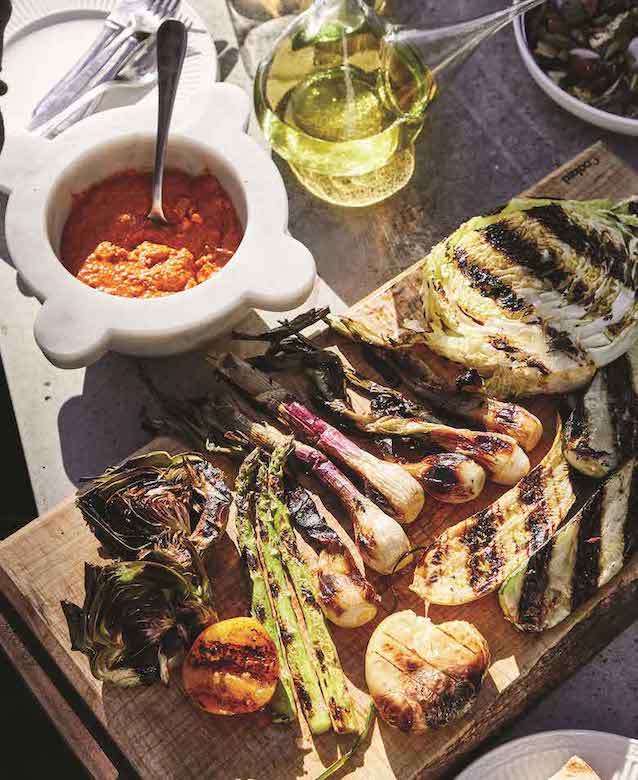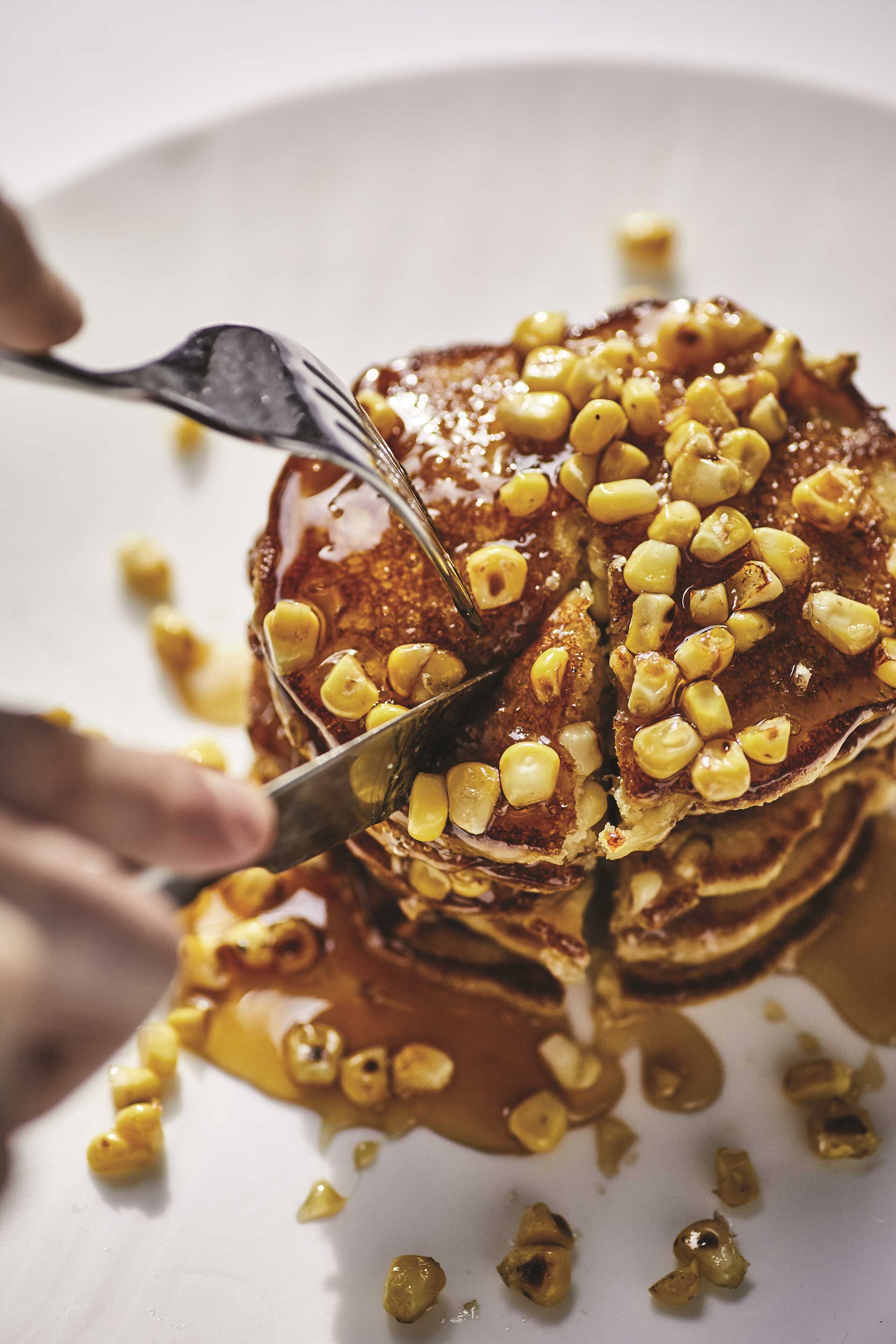José Andrés’ New Cookbook Is a Love Letter to Vegetables
Flipping through José Andrés’ new cookbook, I was hit by one of the stats he presents: “87 percent of American adults don’t meet their daily fruit and vegetable requirements.” Thinking about my meals, I realized I was part of that 87 percent; I had only eaten about a 1/4 cup of veggies total, as part of my leftover curry lunch.
I made a point to fix things the next day: green smoothie for breakfast, massive salad for lunch, roasted vegetables for dinner. It was all delicious, how I’d like to eat every day. But it’s easy to see how things ended up the other way: busy summer travel, too many social engagements and leaning on lazy cooking can all lead to vegetable-less days.
As chef of 30 plus restaurants, founder of the nonprofit World Central Kitchen and active political activist and humanitarian, José Andrés is nothing if not busy. But he’s also set out to change the vegetable void with “Vegetables Unleashed.” It’s his first cookbook in 10 years, written with food journalist Matt Goulding (founder of Roads & Kingdoms), and he’s packed a lot in. “I want this book to be the Anderson Cooper of the plant world: Vegetables 360°” he says.” In the first chapter alone, he covers food waste, food policy issues, and the American obsession with dieting.
“Every bite you take can change the world.”
José Andrés’s First Cookbook in a Decade
You could easily call this an arthouse book—with its touching essays on producers like citrus farmer Jim Churchill and Ron Finley, founder of LA’s community gardening project Gangsta Garden, as well travelogues from his culinary trips around the world. But it’s the recipes I’m excited about to get cooking those vegetables, and it’s clearly what Andrés is all about.
“As José will tell anyone who will listen, nothing in the kitchen is as sexy as cooking vegetables,” says Goulding in the introduction. The recipes run the gamut from waste cooking—including roasting potatoes in compost materials like spent coffee grounds or corn husks—to Spanish vegetarian recipes like paella, to Andrés’ molecular, fussier recipes for vegetable nigiri or creating taco shells out of parmesan cheese. But it mostly offers practical advice for adding more vegetables into your diet, whether it’s eating beet poke and tomato burgers or sneaking vegetables into your cocktail glass. It also has many straightforward recipes for flavorful, simple vegetable preparations.
While I’m not likely to make the more complicated recipes (although I know some adventurous home cooks who will), the book has plenty of approachable recipes to get me thinking about vegetables again. And with summer farmers’ markets in high gear, this is certainly the time to do it. Recipes like his beefsteak sandwich and corn cakes (recipe below) truly highlight pristine produce, reminding readers you don’t need to do much to make an heirloom tomato at the height of summer taste delicious. Along with a kick in the butt to get us to eat our veggies, here are a few other standout ideas from “Vegetables Unleashed.”

Get Your Nose Out of the Book (aka Taste It)
As a cookbook writer, Andrés is walking on thin ice when he says, “cookbooks have limits—they can’t guide you to those special, transcendent moments.” But rather than pushing you towards the special moments one might find in his Michelin-starred restaurants, Andrés is suggesting you seek out the extraordinary flavors of fresh produce: that first bite of Jersey summer corn, a farm fresh juicy heirloom tomato, those unbelievably sweet Michigan cherries.
His corn cakes (recipe below) were inspired by such an experience: after purchasing delicious silver corn at a roadside farm, Andrés tossed the kernels into a simple pancake batter, a recipe from “The Joy of Cooking,” to highlight their sweet flavor. Add an egg on top, and you’ve got a more savory version that can work for dinner. (Save the corn husks, silks and cobs; we got lots of ideas for how to use them!) His beefsteak sandwich puts summer’s juiciest tomatoes on display in a simple sandwich that inspired his chain of vegetable-focused fast casual restaurants. For his Basque-style snow peas, Andrés simply seasons, then char grills the greens. With fruits and vegetables this tasty, there is little work that needs to be done.
Where might you find those special, transcendent flavor moments? The farmers’ market is a great place to start.
Make It Look Like Something You Actually Want to Eat
I recently ordered a prime rib dish, and the “vegetables” served alongside it were four tiny asparagus spears hidden under the hunk of steak, steamed to a grayish green under the heat of the meat. Andrés isn’t suggesting you spend hours with tweezers composing intricate plates like he does at minibar, but if you make it look good, you’re much more likely to enjoy it. (I can’t say those asparagus were very enticing…). He suggests elevating vegetables from sad side into more of star status by serving them in your nicest dishes and adding a garnish like fresh herbs, cheese or chopped nuts. For a vinaigrette, Andrés thinly slices garlic (rather than more typical minced garlic) to add a visual element to a simple salad. White asparagus served with a Manchego cream sauce gets a few shavings of Manchego cheese on top (and the dish looks so much more delicious!) Even a pot of slow-cooked fennel bouillabaisse is finished with a few bright green fennel fronds.
Keeping garnishing in mind is also a great way to reduce your food waste: that little bit of leftover crumbled feta, cilantro stems or citrus peels can all be used to add a little boost of flavor and pizazz to your final dish.

Go Rogue
As a former chef, one of the things that drives me crazy is when friends can’t cook outside the parameters of recipe. “That’s not what the recipe says!” they argue when I suggest adding another ingredient or changing the method slightly. Friends, listen up. While Andrés and his crew of chefs follow recipes to a tee at his restaurants, at home they cook by feel and he suggests you do, too. “Unless you are turning your kitchen into a pop-up restaurant, or baking your first soufflé, which involves chemistry and demands precision, you don’t need to follow every recipe down to the decimal point,” he says.
His tips: rely on your sense of sight and smell to gauge if vegetables are roasted long enough; get comfortable with making substitutions and always taste as you go along. His carrot curry calls for carrots, but think that’s the only vegetable you can make it with? No! He suggests using pumpkin, squash and cauliflower; I challenge you to try it with even more veggies! I’m picking up some eggplant at the farmer’s market this weekend to give it a try.
Get Outside Your Flavor Comfort Zone
Andrés is from Spain and “Vegetables, Unleashed” is peppered with his native dishes like gazpacho and grilled vegetables with romesco sauce. But Andrés pulls inspiration from all over the globe, from Mexican molé to Chinese wok cooking. “Roots are important,” he says, “as long as they don’t hold you in place.” In many ways, the cookbook follows Andrés’ travels around the world. You can visit Greece with his braised green bean Greek dish, Fassolaki Ladera; Lebanon with his fattoush; and Mexico with the tamale-like uchepos. He also encourages play with these recipes. The smashed cucumber salad includes three different flavor variations on the dressing, a Korean version, a Thai one and a Mexican one. And his 20-vegetable fried rice is the perfect dish to try all of these ideas: find some out-of-this-world tasting vegetables to cook with, using whatever you want and make the recipe your own. It’s how José Andrés does it at home, too.
“Do you want a one-word approach to eating that will never fail you? Balance.”

Recipe: Corn Cakes À La Irma Rombauer
José Andrés
Serves 4 (Makes about 16 corn cakes)
Of the thousands of cookbooks I have at home, my copy of an early edition of Joy of Cooking, signed by Mrs. Rombauer, is one of my most beloved. Every cuisine should have a kitchen bible like this— an encyclopedic guide to making all of its most important dishes. No photos, no flash, no tricks, just page after page of no-nonsense recipes. One summer many years ago I pulled over at one of those great roadside stands and bought some amazing silver corn. When I got home, I opened Joy of Cooking, found this recipe, and fifteen minutes later, my family was devouring these incredible little cakes. They make an equally great snack or side dish, or a full meal if you serve them with eggs, which I recommend—try it for breakfast. —José Andrés
Ingredients
1 cup fine stone-ground cornmeal
2 tablespoons butter, melted
teaspoon kosher salt
1 cup boiling water
½ cup whole milk
1 large egg
2 medium ears corn, shucked, silks removed, and kernels cut off (about 1½ cups)
½ cup all-purpose flour
2 teaspoons baking powder
Butter or oil for greasing the pan
Garnish
Honey (optional)
Cooked corn nuts or corn kernels
Maldon salt
Method
Combine the cornmeal, butter, and salt in a medium heatproof bowl. Add the boiling water and stir until smooth. Cover and let sit for 10 minutes.
Whisk the milk with the egg in another bowl, until frothy. Fold into the cornmeal mixture, along with the corn kernels.
Mix the flour with the baking powder in a small bowl, then fold into the batter just until incorporated.
Lightly grease a griddle or a large skillet and heat over medium-high heat. For each corn cake, pour ¼ cup of the batter onto the griddle to form a thin cake about 3 inches in diameter; do not crowd the pan. Cook the cakes until bubbles appear on the surface, 2 to 3 minutes, then flip the cakes and cook until golden on the bottom, 30 seconds to 1 minute longer. Remove from the griddle and continue to make more cakes.
To serve, garnish each corn cake with a drizzle of honey (if using), a few corn nuts or fresh kernels, and a pinch of Maldon salt.
Recipe Note
You could serve these cakes with a dozen different condiments—from fresh mango salsa to guacamole to a few dashes of your favorite hot sauce. I’m a purist, so I eat them as is, but feel free to experiment.
Excerpt from “Vegetables Unleashed” by José Andrés and Matt Goulding. Copyright 2019 by José Andrés. Excerpted by permission of Ecco, an imprint of HarperCollins Publishers.
More Reading
15+ ideas for delicious meatless grilling
July 1, 2025
4 Tips for Stretching Your Food Dollars
April 16, 2025
How to use extra onions
April 9, 2025
Our latest podcast episode on pistachios: The making of a food trend
April 1, 2025
This vegan tiramisu will bring you joy
March 11, 2025
For lessons in thrifty, climate-friendly cooking, look to vintage cookbooks
March 10, 2025
Americans love olive oil. Why doesn't the U.S. produce more of it?
February 28, 2025
How to fight household food waste? Join our Eat Down Your Pantry Challenge!
February 13, 2025
During a period of egg chaos, egg replacements for (almost) any situation
February 7, 2025
Ways to go meatless — or less-meat — in January
January 15, 2025
